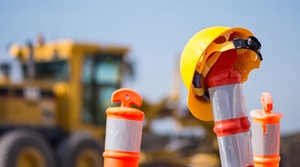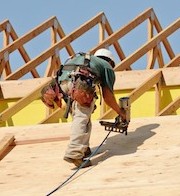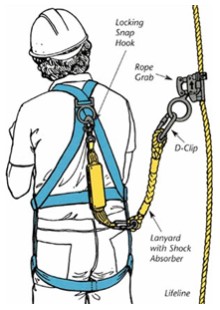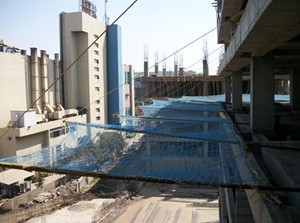
By Brian Stearns, Alpine SnowGuards
One of the most dangerous industries to work in is the construction industry. 20% of all employees that died on the job last year were employed as construction workers. Roofers in particular account for the highest rate of job-related deaths. This has
been a pretty consistent statistic over the past few years, so why aren’t these deaths being prevented?
 We
see it constantly - reports of roofing and construction companies being cited for violations and fined after a worker dies from a fall. I’ve also noticed that on MANY roofing company’s websites, their “hero”, or home page image
is often that of a worker on the roof, WITH NO FALL PROTECTION. It’s surprising to me that companies would be so careless.
We
see it constantly - reports of roofing and construction companies being cited for violations and fined after a worker dies from a fall. I’ve also noticed that on MANY roofing company’s websites, their “hero”, or home page image
is often that of a worker on the roof, WITH NO FALL PROTECTION. It’s surprising to me that companies would be so careless.
With falls being the #1 cause of preventable construction deaths, I thought it would be a good idea to shed a little light on what the vast majority of the industry already knows, and what the rest needs to make sure they know.
Your and your workers' lives depend on it.
 OSHA
has set forth some pretty clear parameters of what’s required on job sites in relation to falls, especially since falls account for almost 40% of all construction related deaths. 40%!
OSHA
has set forth some pretty clear parameters of what’s required on job sites in relation to falls, especially since falls account for almost 40% of all construction related deaths. 40%!
By supplying construction workers with OSHA’s 3 required methods of fall protection, falls can be prevented, and workers can breathe easier knowing that there are several safety systems in place to help protect their lives.
Personal fall arrest systems, safety nets, and guardrails are hugely important safety methods that all employers need to use - they’re not only smart choices, they’re required.
What do each of these systems do, and why are they important? Guardrails prevent a fall from occurring in the first place, while personal fall arrest systems and safety nets were designed to stop a worker who’s fallen from falling even further or
from coming into contact with lower levels.
 In
the building and construction industry, fall protection is required for anyone working more than 6 feet above a lower level (10 feet when working on scaffolding). When a worker is working above any dangerous equipment or machines, including things
like rebar that can impale a worker, fall protection is also required.
In
the building and construction industry, fall protection is required for anyone working more than 6 feet above a lower level (10 feet when working on scaffolding). When a worker is working above any dangerous equipment or machines, including things
like rebar that can impale a worker, fall protection is also required.
Personal fall arrest systems have 3 components: anchorage, a connecting device, and a full body harness. The system's D-rings, hooks, vertical lifelines, and lanyards must have a minimum breaking strength of 5,000 pounds, and must withstand a 400 pound
bag of sand being dropped on them to prove they can absorb the force. They also must be inspected before every use, as well as after every fall.
 Same
with safety nets - 5,000 pound breaking strength and a 400 pound sand bag drop test are both required. Also, the net must be placed no further than 30 feet below the surface the worker is working on, and netting should ideally be placed as close as
possible to where the worker is.
Same
with safety nets - 5,000 pound breaking strength and a 400 pound sand bag drop test are both required. Also, the net must be placed no further than 30 feet below the surface the worker is working on, and netting should ideally be placed as close as
possible to where the worker is.
Scaffolding and guardrails play a major part in fall protection, too. Guardrails are normally used around unprotected edges and scaffolding is used around openings like elevator shafts and skylights.
 All
of these safeguards were designed to save lives, and they have in many instances. But when they’re not even available for use, they can’t possibly save lives, that’s why it’s up to the employer to not only provide them, but
to also ensure that the systems they use are constructed properly and are set up and supervised by a competent worker. Making sure all of your employees have proper training to prevent fall hazards is also a requirement that is all too often overlooked.
All
of these safeguards were designed to save lives, and they have in many instances. But when they’re not even available for use, they can’t possibly save lives, that’s why it’s up to the employer to not only provide them, but
to also ensure that the systems they use are constructed properly and are set up and supervised by a competent worker. Making sure all of your employees have proper training to prevent fall hazards is also a requirement that is all too often overlooked.
 If
you take a look back to the 1970’s, you’ll see that we’ve come a long a way. In the 70’s, construction workers died on the job at a rate of about 38 workers a DAY! In 2017, that number dropped to about 13 workers per day. Still
way, WAY too many...please, protect yourself, your employees, and your reputation, so we can all build a better future.
If
you take a look back to the 1970’s, you’ll see that we’ve come a long a way. In the 70’s, construction workers died on the job at a rate of about 38 workers a DAY! In 2017, that number dropped to about 13 workers per day. Still
way, WAY too many...please, protect yourself, your employees, and your reputation, so we can all build a better future.
For more information, visit the United States Department of Labor page entitled PLAN. PROVIDE. TRAIN.